Pretty much every single prepper by now understands the importance of having a reliable, safe water supply during any kind of emergency. In fact, I don’t think it’s any stretch at all to assert that every human being instinctively understands that! This is not esoteric knowledge, here.
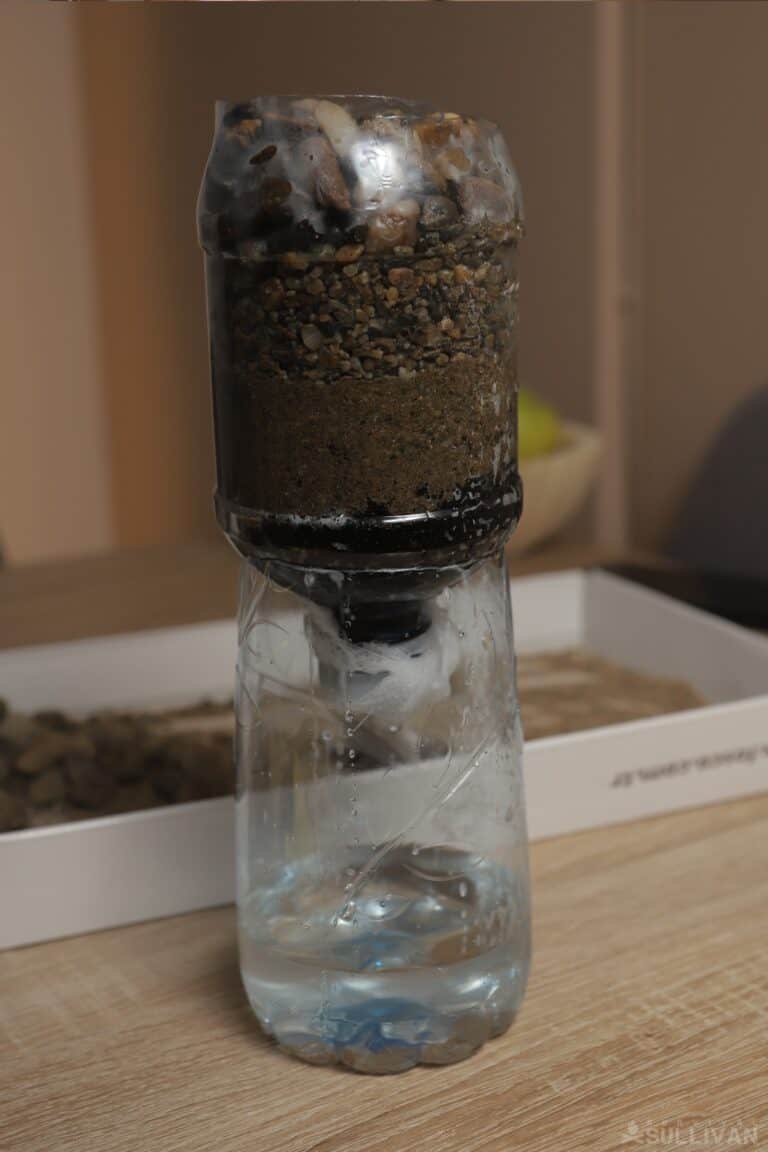
But knowing it and guaranteeing that supply are two different things, and for all the stockpiled water and fancy water filtration tech that you might invest in, things can still go wrong and you’re back to square one but nothing but questionable water and growing thirst.
In such a case, knowing how to create your own simple and effective water filter might make the difference between survival and death.
It’s easier than you think, and I’ll show you how in this article.
How Does Charcoal Filter Water?
If you’ve paid any attention to various filters, be they for your refrigerator or a field model for your survival kit, you know that charcoal is commonly advertised as a component of these things. But why is that? What makes charcoal so useful for water filtration?
Charcoal filtering is so popular because it is an effective way of removing impurities, certain chemicals, and unwanted tastes and odors that may be present in tap water or natural sources.
[TAG1]
Charcoal works this way because it is a powerful adsorbent, meaning that it can attract and hold various types of molecular particles, ions and compounds on its surface.
Activated charcoal in particular has an enormous surface area and can create an immense number of tiny pores that trap those aforementioned impurities, chemicals, and pollutants.
Inside any filter, water moves through this network of pores and channels that essentially “catch” and hold those unwanted substances, leaving the now-cleaned water to move on.
The adsorption process results in clear, odor-free and fresh-tasting water that is suitable for drinking and various other tasks.
Can You Use Charcoal Alone?
You can, but you shouldn’t for reasons of efficiency and longevity. Overall, charcoal filtering through activated carbon is a simple yet effective way of purifying water, but charcoal alone will quickly be overwhelmed if you are filtering some seriously dirty water through it.
It has a lifespan, you might say, and overloading it is a good way to get it to stop working!
You can make activated charcoal work even better by assembling it as the last or second to last stage of a filter, each progressively finer than the last, where it has the relatively easy job of catching only the tiniest contaminants. It will also work much longer done this way!
Use Only Activated Charcoal!
We’ll get to the actual how-to of assembling your DIY filter in one moment, but there is one more important thing you must know before you begin: you must use activated charcoal for this filter, not just any old charcoal and definitely not grill or BBQ charcoal!
You can find specially made and finely ground activated charcoal at most hardware stores and also online.
Grill charcoal has way too many chemical components that will leach into your “clean” water and cause harm. Don’t do it!
But what is activated charcoal and how does it get “activated” in the first place? It’s a straightforward process that involves heating carbon-rich materials such as wood, sawdust, or coconut shells to very high temperatures with a limited amount of oxygen.
This is called the activation process because it creates those thousands of tiny pores in each grain of material, thereby “activating” it for this purpose.
The resulting activated charcoal is then be packed into filters and used to remove impurities in water or other substances.
It is cheap and easy to find, but if you can’t it is entirely possible to make your own, but that is a subject for another article!
Making Your Own DIY Charcoal Water Filter, Step by Step
Time to get down to business. The following steps will tell you how to make a very basic charcoal-based filter that will do a surprisingly good job of purifying water.
It is simple, straightforward, and uses plentiful components materials, making a great option for survival situations.
First things first: what do you need?
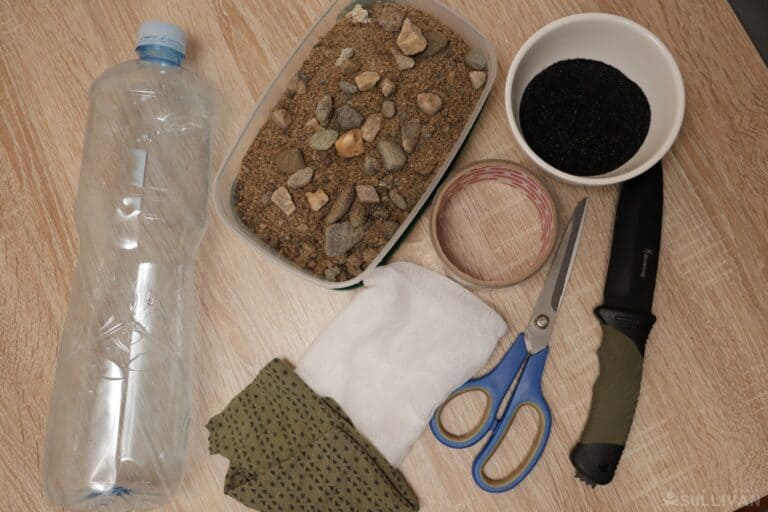
Supplies
Filter Body – a container that you will use to hold your filtration media. A 2-liter (or 1 liter or 1.5 liter) plastic soft drink bottle is ideal, but you can use a smaller plastic bottle, a plastic bucket, or anything else that will hold water and not leak.
Pre-filter – this should be a relatively coarse cloth that will catch large debris as you pour in the water. Think bandana, t-shirt, old towel, etc. It goes on top of the filter and is technically a first stage.
Final filter – a super-fine woven cloth that catches the tiny particles of charcoal and other filter media that have worked their way down through the filter. Cheesecloth, coffee filters, and similar items are ideal.
Filtration Media – the stuff that actually does the filtering! This includes activated charcoal, which we discussed above, and other substances such as sand and gravel.
You want a progression from coarsest to finest, moving lower in the filter body: larger pieces of gravel, then pea-sized gravel, mustard seed-sized gravel, sand, and then charcoal.
Collection Container – The container that catches your filtered water. Should be very clean and watertight, obviously!
Tools – a few handy tools for shaping and modifying plastic and crushing media will make this easier; sturdy scissors, knife, tape, mortar and pestle (or natural equivalent) etc.
And that’s it. I told you it was simple. Now, on to the steps. Pay attention, take your time, and you’ll have a working, effective filter in no time.
Step 1: Sort and Crush The Media, if Necessary
Use your mortar and pestle (or equivalent) to crush the largest pieces down to the prescribed size.
Use a strainer to sort out the smaller gravel from the larger pieces. Pretty easy so far, right?
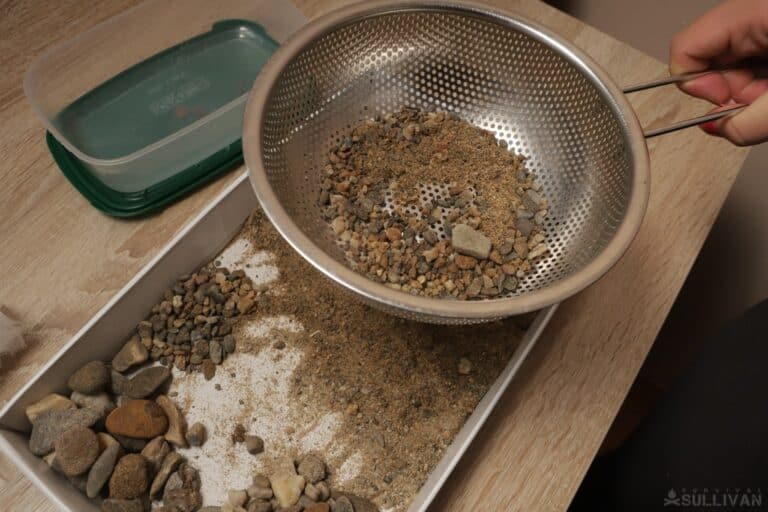
Step 2: Prepare Filter Body
Now, assess the container your have chosen. Most won’t need much modification, and keep in mind a larger container will work a little quicker and filter more water for more people in a timely fashion.
If using the 2-liter mentioned above, leave the cap on (if present) and cut the bottom off, leaving the walls of the cylinder straight and level. You should have a funnel at this point, basically.
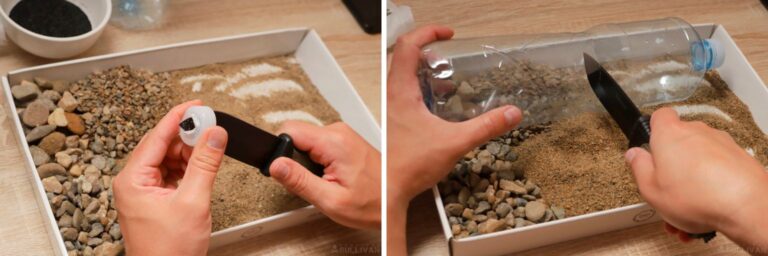
cutting and carving the water bottle and the cap collage
If using another container, you’ll need to drill a hole in the bottom so that gravity will take the water through the filter and out the bottom to be collected.
Step 3: Soak Activated Charcoal, Let Dry
Time to pre-treat your charcoal. Yes, we need to pre-treat it. This is done by rinsing the charcoal and leaving it on a cloth or in a container to dry.
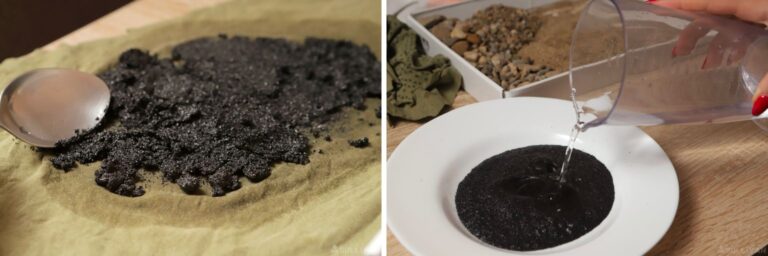
soaking and then drying the activated charcoal collage
Use enough that it will make a layer in your container about 2″ deep. Once the charcoal has dried out, you are ready to move on.
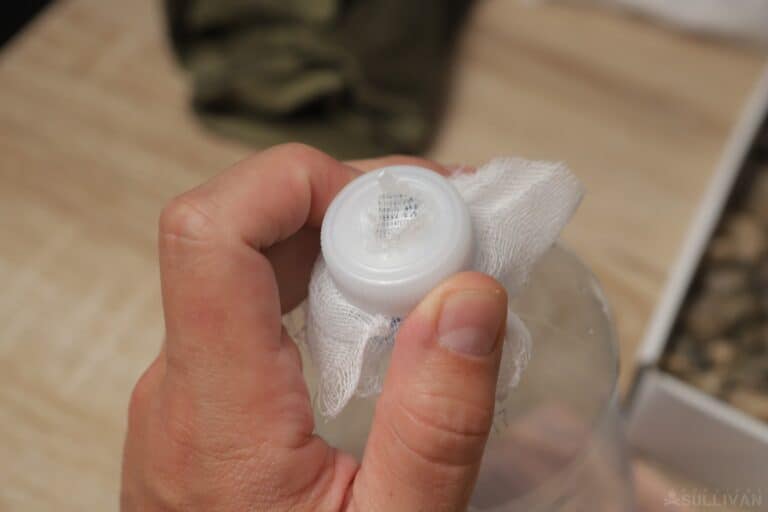
Step 4: Assemble, Bottom to Top
Start adding your layers, starting with the bottom and working up and adding at least two inches of filtration media, packing each layer lightly and neatly:
- Final Filter Cloth
- Charcoal
- Sand
- Fine Gravel
- Coarse Gravel
- Pre-filter Cloth
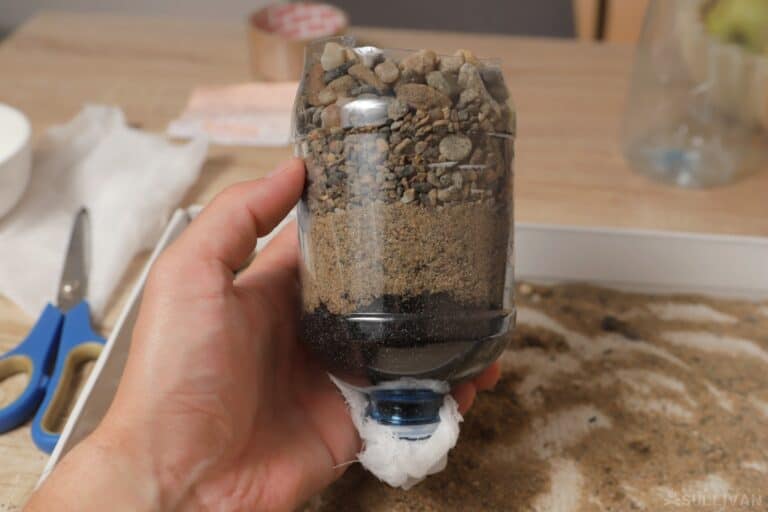
The idea is that the water is cleaned of progressively smaller and smaller particles as it works its way down through the filter.
Done right, the water coming out the other end will look drastically different than when it went in!
Step 5: Test
Time to give it a whirl. Place your collection container then gather your water, and remove the largest, nastiest chunks from it.
Strain it prior to adding it to your filter, if necessary. Pour the water in slowly and watch as it filters through.
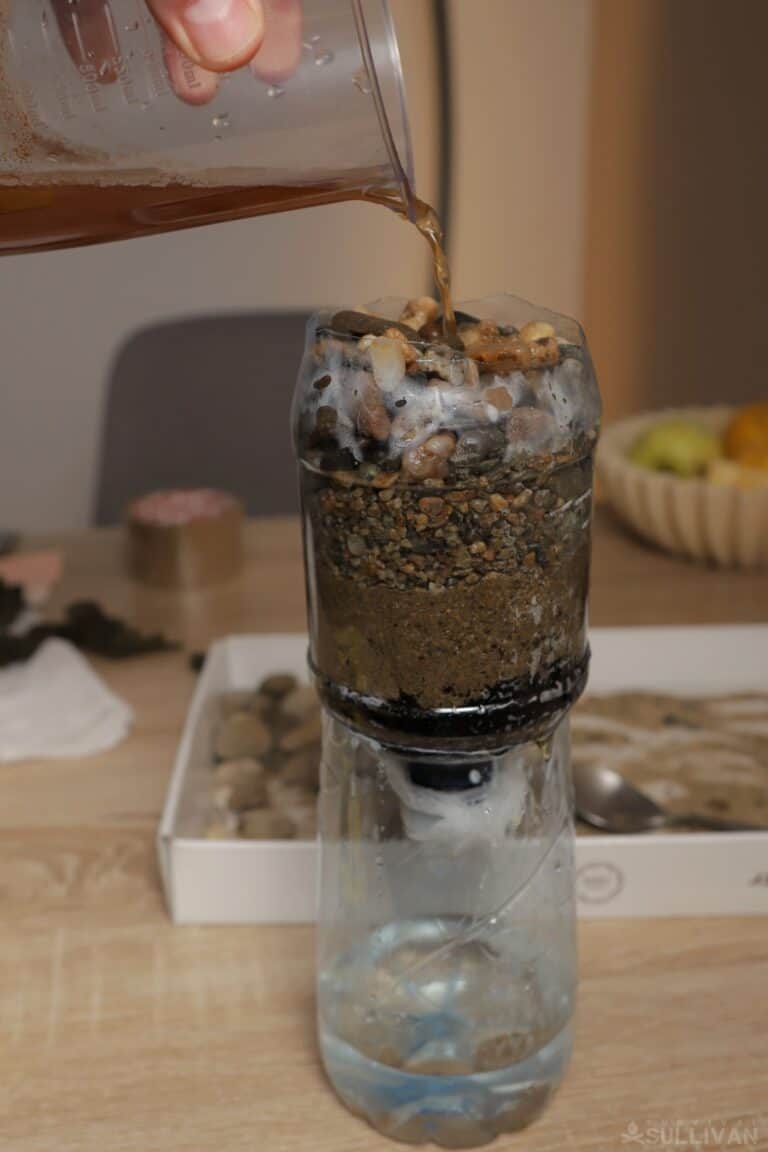
This will take some time depending on the size and density of your filter layers! A slow trickle of water is normal!
Collect your clean water, but don’t drink it yet, there is more to do.
Proper Filtration Will Slow Down Water Flow!
One thing to keep in mind is that purifying water through a gravity-fed filter like this is not like getting water from a tap; it will take time for the water to work its way through!
That said, as soon as the water comes out the other end, assuming it didn’t just drop through in a second or two, it is considered “filtered.”
This sluggishness is the last thing people want to deal with when they and others are thirsty, but resist the urge to “help” the water get through quicker by thinning out layers, using larger media granules or omitting layers entirely.
Your DIY filter is effective because the water is scrubbed, in a way, as it slowly makes its way to the bottom.
If you pour in your water and it takes 30 seconds or so for any to start coming out, but it does come out in a steady trickle your filter is good to go.
But if it stops up entirely, or comes out in fits and starts or drops, you might have packed your layers too tightly. Be patient, and give your filter time to work before you tinker with it!
You Must Still Treat Water for Pathogens!
One critical shortcoming to keep in mind is that your filter, and activated charcoal, is not enough to remove all contaminants, specifically certain kinds of bacteria, viruses, and potentially parasites.
This necessitates you resort to boiling- even after filtering- in order to totally purify your water.
Some of the most common waterborne pathogens include E. coli, Giardia lamblia, Cryptosporidium, Norovirus, Campylobacter, and Legionella.
All of them are bad news, and can compromise you during what is already a life-threatening ordeal.
Yes, it takes more time and energy to boil your water, but with this crucial step done your water will be as safe and sound to consume as possible under the circumstances.
Boiling is, of course, the surest and swiftest way to kill waterborne germs in most survival situations, but you do have other options. Consider the following effective methods:
- UV Emitter Sterilization- A small gadget that works great on clarified water. Drop it in and turn it on. A few minutes later, your water is safe. Add one to your kit!
- Sunlight Sterilization- The natural version of the above technique. A clear container left in direct, bright sun for 6 or so hours will be germ-free.
- Chemical Disinfection: An old standby. Chemical liquids and tablets can nuke germs, and are easy to transport and use. Usually makes water taste bad, though.
Frequently Asked Questions
How long do DIY charcoal filters take to work? It depends on several factors including the size of the filter, the type of materials used, and how much water is being filtered.
Generally speaking, it can take anywhere from 5 minutes and up for a charcoal filter to start working.
How long will my DIY charcoal filter last? A DIY filter might be able to effectively clean a few gallons of water or several dozen depending on contamination levels.
A smaller filter may need to be changed out or rebuilt more often than a bigger one, and water that is particularly dirty will reduce the lifespan of your filter dramatically.
Can I reuse my DIY charcoal filter? Yes, you can reuse your DIY charcoal filter if it is still producing clear water, and when it wears out you can “rebuild” the innards by replacing all of your filtration media with new, clean layers.
What can you use if you don’t have activated charcoal? If you don’t have access to activated charcoal, you can use alternatives such as wood ash, sawdust, or diatomaceous earth.
Just make sure the material is finely ground in order for it to do its job properly, and know that none of these work as well as charcoal.
Where Can I Get Good Activated Charcoal? You can get good activated charcoal from many online retailers like Amazon, at some hardware stores, pet shops, and chemical supply outlets.
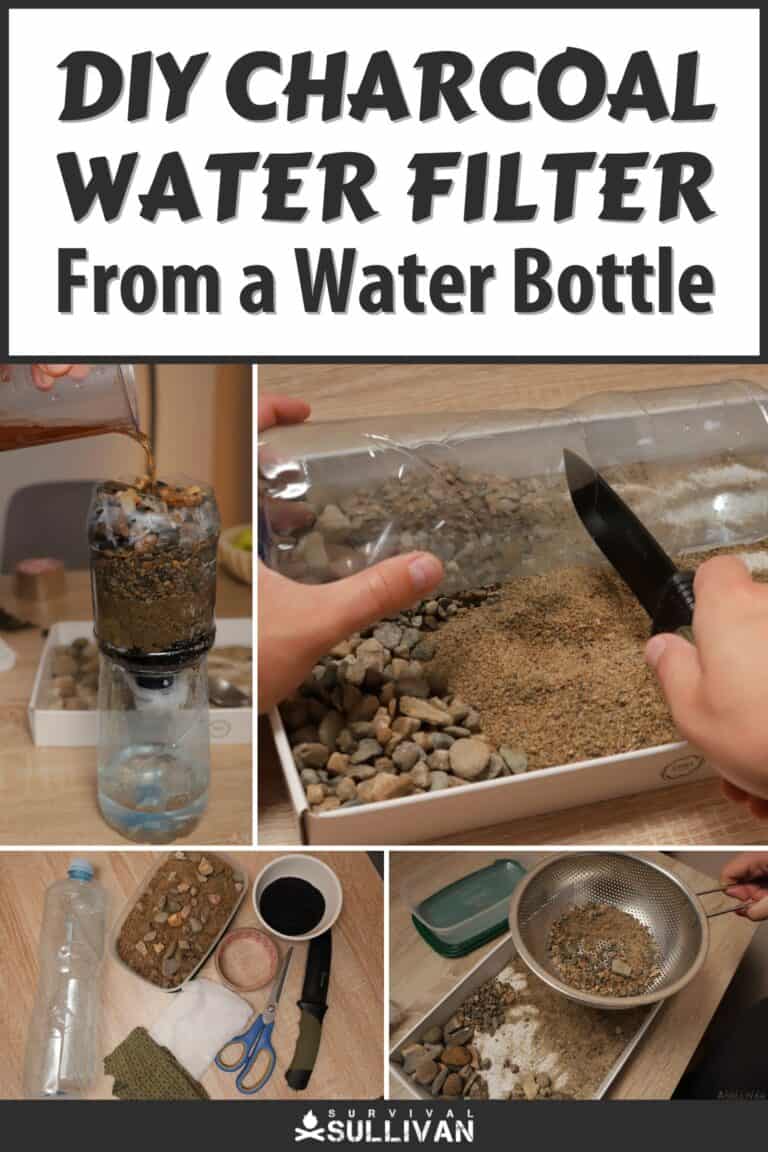
The post DIY Charcoal Water Filter From a Water Bottle appeared first on Survival Sullivan.
By: Tom Marlowe
Title: DIY Charcoal Water Filter From a Water Bottle
Sourced From: www.survivalsullivan.com/diy-charcoal-water-filter/
Published Date: Thu, 01 Jun 2023 16:00:00 +0000
------------------------
 What is BushcraftSurvival SkillsToolsVideosBushcraft CampsBushcraft KitsBushcraft ProjectsPrivacy PolicyTerms And Conditions
What is BushcraftSurvival SkillsToolsVideosBushcraft CampsBushcraft KitsBushcraft ProjectsPrivacy PolicyTerms And Conditions
